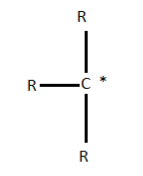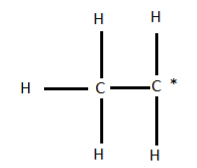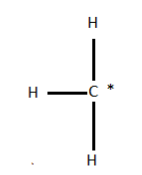
The alkyl radical with most stability is:
A. Ethyl radical
B. Methyl radical
C.
D.
Answer
481.8k+ views
Hint: To answer this question you need to know the molecular formula and structure of all the radicals. Alkyls are basically alkane with one hydrogen missing. So, if we know alkanes then we can know alkyls of ethyl and methyl.
Complete step by step answer:
In organic chemistry, an alkyl substituent is basically alkane with one hydrogen missing. For example, cycloalkyl is derived from cycloalkane with one hydrogen atom removed and its general formula is
Alkyl radical is any series of universal groups of the general formula

Ethyl radical has a molecular formula

Methyl Radical is an organic compound with the chemical formula

Butyl is a four carbon alkyl radical or substituent group with general chemical formula as

The general trend in radical stability is
Therefore, the answer is option D.
Note:
Having knowledge of alkanes can help here with alkyls. The 2 degree and 3 degree butyl properties should be known and the difference between them so that there is no confusion on the number of carbon and hydrogen atoms present in the molecules.
Complete step by step answer:
In organic chemistry, an alkyl substituent is basically alkane with one hydrogen missing. For example, cycloalkyl is derived from cycloalkane with one hydrogen atom removed and its general formula is
Alkyl radical is any series of universal groups of the general formula

Ethyl radical has a molecular formula

Methyl Radical is an organic compound with the chemical formula

Butyl is a four carbon alkyl radical or substituent group with general chemical formula as

The general trend in radical stability is
Therefore, the answer is option D.
Note:
Having knowledge of alkanes can help here with alkyls. The 2 degree and 3 degree butyl properties should be known and the difference between them so that there is no confusion on the number of carbon and hydrogen atoms present in the molecules.
Recently Updated Pages
Master Class 12 Economics: Engaging Questions & Answers for Success

Master Class 12 Maths: Engaging Questions & Answers for Success

Master Class 12 Biology: Engaging Questions & Answers for Success

Master Class 12 Physics: Engaging Questions & Answers for Success

Master Class 12 Business Studies: Engaging Questions & Answers for Success

Master Class 12 English: Engaging Questions & Answers for Success

Trending doubts
Draw a labelled sketch of the human eye class 12 physics CBSE

Phenol on treatment with conc HNO3 gives A Picric acid class 12 chemistry CBSE

Differentiate between homogeneous and heterogeneous class 12 chemistry CBSE

Which sugar is called invert sugar Why is it called class 12 chemistry CBSE

a Give chemical tests to distinguish between 1 Propanal class 12 chemistry CBSE

What are the major means of transport Explain each class 12 social science CBSE




